

Nanoparticles cause DNA damage - without even entering cells. New researched published in Nature Nanotechnology shows that nanoparticles can damage DNA and chromosomes in cells, across an intact barrier of other cells.
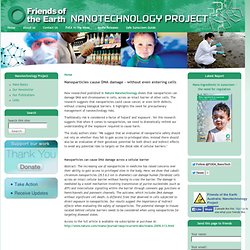
The research suggests that nanoparticles could cause cancer, or even birth defects, without crossing biological barriers. It highlights the need for precautionary management of nanotechnology risks. Traditionally risk is considered a factor of 'hazard' and 'exposure'. Yet this research suggests that when it comes to nanoparticles, we need to dramatically rethink our understanding of the 'exposure' required to cause harm. The study authors state: "We suggest that an evaluation of nanoparticle safety should not rely on whether they fail to gain access to privileged sites.
Nanoparticles can cause DNA damage across a cellular barrier Abstract: The increasing use of nanoparticles in medicine has raised concerns over their ability to gain access to privileged sites in the body. Olhar Nano - Preparação de mono camada hidrofóbica sobre prata e visualização do efeito Lótus %> A conhecida planta Lótus (Nelumbo Nucifera) cresce, em geral, em ambiente úmido e empoeirado.
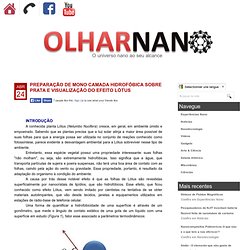
Sabendo que as plantas precisa que a luz solar atinja a maior área possível de suas folhas para que a energia possa ser utilizada no conjunto de reações conhecido como fotossíntese, parece evidente a desvantagem ambiental para a Lótus sobreviver nesse tipo de ambiente. Entretanto, essa espécie vegetal possui uma propriedade interessante: suas folhas "não molham", ou seja, são extremamente hidrofóbicas. Isso significa que a águe, que transporta partículas de sujeira e poeira suspensas, não terá uma boa área de contato com as folhas, caindo pela ação do vento ou gravidade. Essa propriedade, portanto, é resultado da adaptação do organismo à condição do ambiente.
A causa por trás desse notável efeito é que as folhas de Lótus são revestidas superficialmente por nanocristais de lipídios, que são hidrofóbicos. Figura 1. The darker side of nanotechnology: nanotoxicology. Over the past few years, R&D in the field of nanotechnology has been taking place at a breathtaking pace.
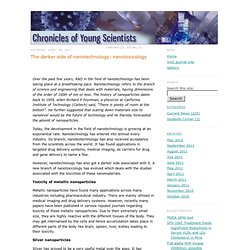
Nanotechnology refers to the branch of science and engineering that deals with materials, having dimensions of the order of 100th of nm or less. The history of nanoparticles dates back to 1959, when Richard P Feynman, a physicist at California Institute of Technology (Caltech) said, "There is plenty of room at the bottom".
He further suggested that scaling down materials size to nanolevel would be the future of technology and he thereby forecasted the advent of nanoparticles. Today, the development in the field of nanotechnology is growing at an exponential rate. Nanotechnology has entered into almost every industry. However, nanotechnology has also got a darker side associated with it. Toxicity of metallic nanoparticles Metallic nanoparticles have found many applications across many industries including pharmaceutical industry. Current Studies into the Genotoxic Effects of Nanomaterials. Nanotechnology/Health effects of nanoparticles.
The environmental impacts of nanotechnology have become an increasingly active area of research.

Until recently the potential negative impacts of nanomaterials on human health and the environment have been rather speculative and unsubstantiated[1]. However, within the past number of years several studies have indicated that exposure to specific nanomaterials, e.g. nanoparticles, can lead to a gamut of adverse effects in humans and animals [2], [3], [4]. This has made some people very concerned drawing specific parallels to past negative experiences with small particles [5], [6].
Nanomaterials. Nanotechnologies make use of very small objects or artefacts.
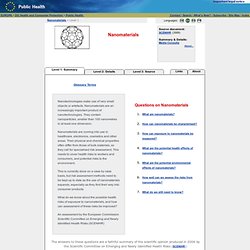
Nanomaterials are an increasingly important product of nanotechnologies. They contain nanoparticles, smaller than 100 nanometres in at least one dimension. Nanomaterials are coming into use in healthcare, electronics, cosmetics and other areas. Olhar Nano. NanoToxic - Your Nanotechnology Toxicology Resource. Tiny nanoparticles could be a big problem. Nanomaterials—tiny particles as little as 1/100,000 the width of a human hair—have quietly been used since the 1990s in hundreds of everyday products, everything from food to baby bottles, pills, beer cans, computer keyboards, skin creams, shampoo, and clothes.
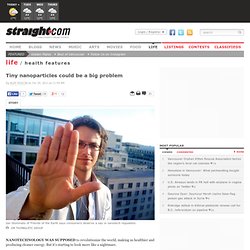
But after years of virtually unregulated use, scientists are now starting to say the most commonly used nanoproducts could be harming our health and the environment. One of the most widespread nanoproducts is titanium dioxide. More than 5,000 tonnes of it are produced worldwide each year for use in food, toothpaste, cosmetics, paint, and paper (as a colouring agent), in medication and vitamin capsules (as a nonmedicinal filler), and in most sunscreens (for its anti-UV properties). In food, titanium-dioxide nanoparticles are used as a whitener and brightener in confectionary products, cheeses, and sauces. Other nanoparticles are employed in flavourings and “nutritional” additives, and to reduce fat content in “health” foods.